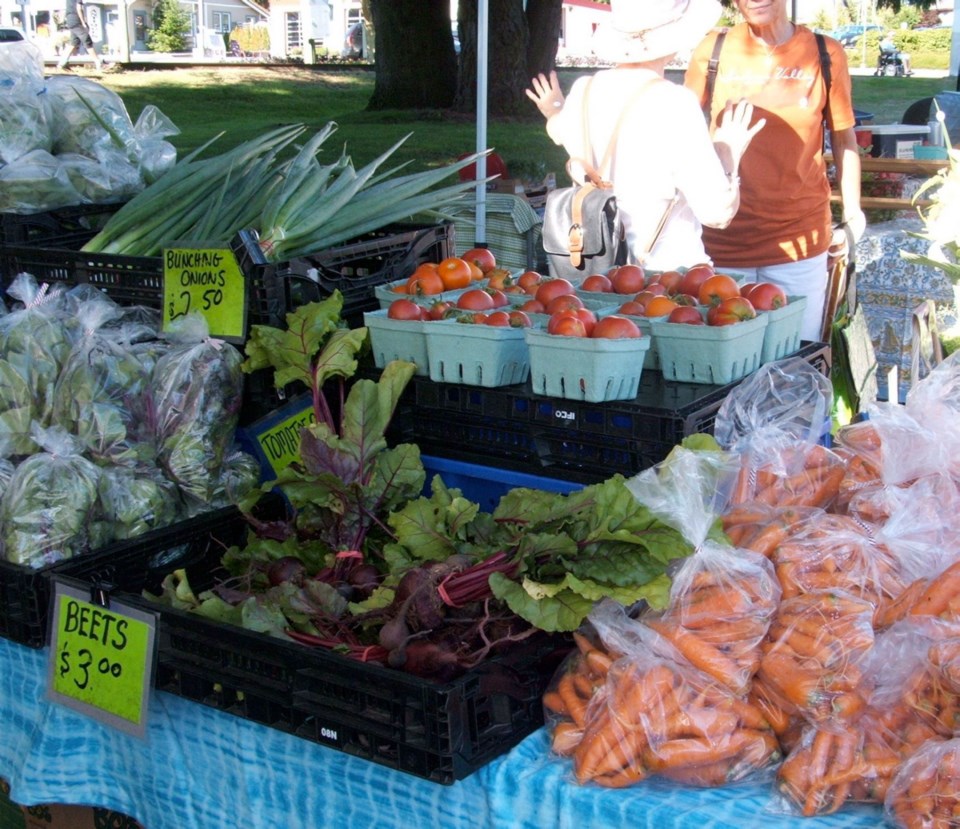Almost every Saturday morning, I visit favourite stalls at my local farmers’ market to see what’s on offer, ask questions, and exchange thoughts on the season and abut what’s growing well or not.
It’s a chatty, friendly interlude in the week, with friends to catch up with and regulars to greet. I almost always come away with some useful or at least interesting gardening information.
As it often is, my first stop at the latest market was at Elsa’s stall, where I reward the week’s work with her fruit squares and brownies. She also sells wonderfully fresh salad greens and gloriously lavish bouquets of flowers.
Kathy has been a source for the extra blueberries I need to supplement my garden’s output. In August I also indulge in her greenhouse-grown Canadice grapes — small, red, seedless, sweet and delectable.
This summer I felt an urge to make red raspberry jam to go along with the jam I make from my Fall Gold berries. Kathy has big, luscious Autumn Bliss raspberries, probably the most popular among the “everbearing” kinds for its generous yields and good flavour. The jam is delicious.
At another stall, Rob tells me her prefers Amity, an everbearing variety he obtained from a friend’s garden. The colour of Amity raspberries is not the deep red of Autumn Bliss, but Rob finds the flavour superior.
Rob’s wife Laura joined us to tell me about something new they are growing this year — an odd item called “mouse melon,” a South American native vining plant that produces tiny fruits with marbled skin and a sour cucumber flavour. They are used in stir-fries, pickling, and salsas. The common Spanish name, “sandia de raton,” means mouse-sized watermelon. Rob and Laura found mouse melon listed with the Bitter Melon varieties in the William Dam Seeds catalogue.
Few of us are able to grow every fruit and vegetable we need. Buying at a farmer’s market is the next best thing. As well, it’s not uncommon at markets to find unfamiliar types of fresh produce to try. Chances are you’ll discover new treats to grow in your own garden.
I sense an atmosphere of respect and cordiality at farmers’ markets. Immersing oneself in it even briefly can create a momentary feeling that all may be right with the world after all.
Garlic and ten mothers. There has been much more mail than usual about garlic this summer, because of diseases that have become more prevalent in home gardens. In June, I saw a friend's garlic planting in Duncan ruined by white rot.
My garlic patch, thank goodness, stayed healthy and gave me a fine yield. Star of my 2015 garlic show is ‘Music,’ a strong-growing hard-neck, Porcelain type with large, juicy, strong-tasting cloves.
Soon after I had dried off and stored my garlic, I noticed a television listing on the Turner Classic Movies (TCM) channel for Garlic Is As Good as Ten Mothers. I had to watch.
The program turned out to be a rollicking 1980 Les Blank documentary filled with lively kitchen scenes, chopping and stirring, singing and music — mainly Zydeco, Spanish, and folk. The documentary moved through several kitchens, catching various ethnic flavours. In an Italian home the father in the family insisted on having a whole head of garlic in the pasta sauce.
The recipes went by so fast it was hard to absorb it all, and there is one I've been trying to chase down. It was an unusual combination of figs, garlic, honey, red wine, orange peel and rosemary, cooked together in a sauce that I think can be used as is, for a sauce, or strained and used as a syrup.
The film's colours are vivid, the personalities in it large and robust. Almost all of them emphasized the health benefits of garlic.
Roasted figs. That unusual recipe prompted new thoughts on using figs. One idea that emerged was to try roasting them. I cut fresh figs into quarters and placed them on an oiled pan to roast at 325 F for around a half hour or until they have caramelized and before they begin to burn.
The little morsels are scrumptious, and far more intensely flavoured than figs that have been dried. For the latest pot luck gathering at my house I made a salad of mixed greens tossed in a balsamic vinegar and oil dressing and topped with the roasted fig pieces, toasted pecans, and small dollops of soft goat cheese. It was very well received.



